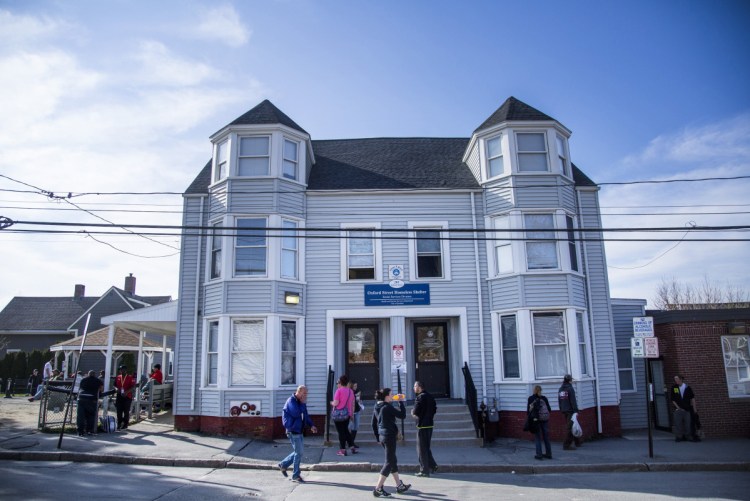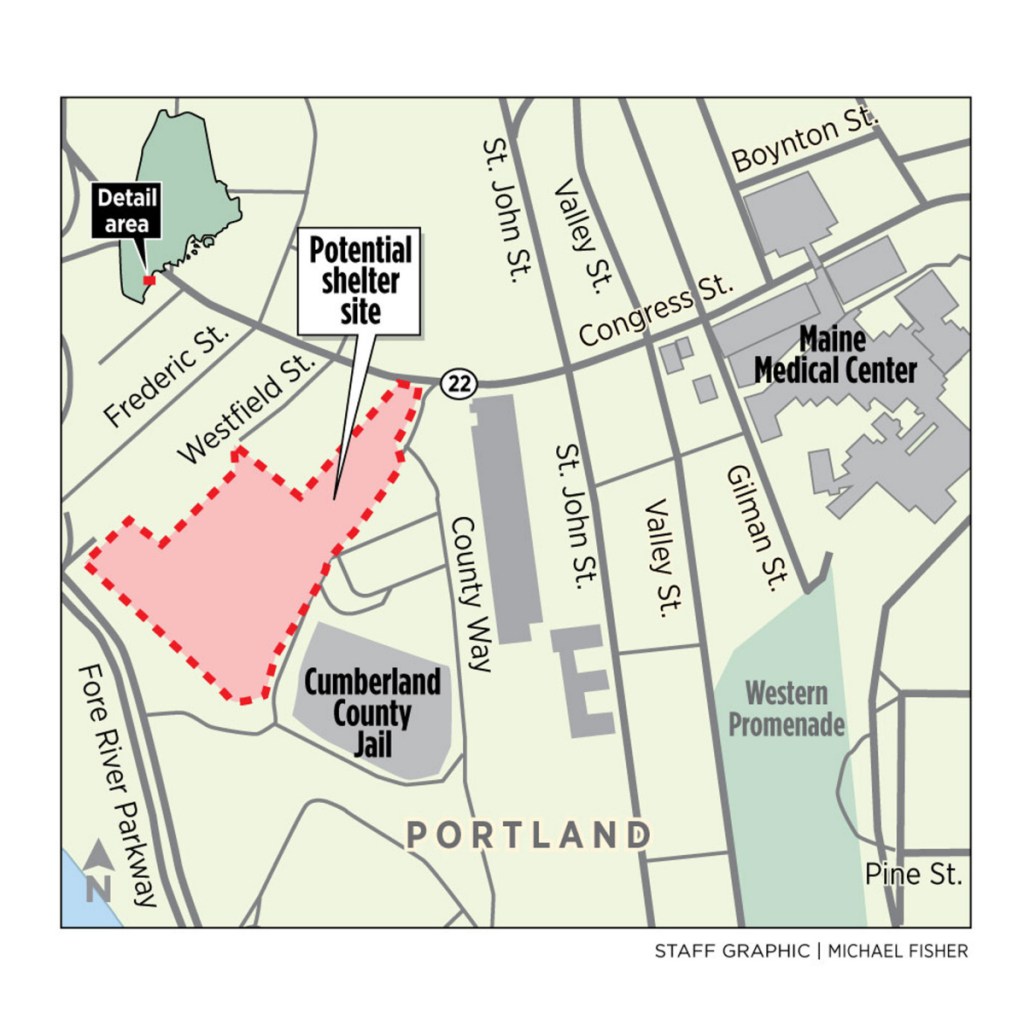Today, the 10-acre swath of land in Portland’s Libbytown neighborhood is largely undeveloped. Stretching from Congress Street down to the Fore River, the land is nestled in between a residential neighborhood on Frederic Street, tucked behind an industrial pocket with a craft brewery and next to the Cumberland County Jail.
But in the future, it could become the site of Portland’s new homeless services center.
The land is included on a list of 11 potential sites being considered by a City Council subcommittee. And it appears to be one of the few that have many of the attributes desired by councilors, who last year informally endorsed the creation of a new 150-bed city-operated shelter. That shelter, along with smaller facilities run by community partners, would replace the outdated and overcrowded Oxford Street Shelter for single adults.
The so-called County Way site is near the downtown area and well connected to public transit. It’s located between two hospitals. And there appears to be enough land to build a single-story shelter with a screened-in courtyard for guests.
City officials last week confirmed they have been in discussions with the state about acquiring some or all of the land, which is owned by the Maine Department of Transportation.
“Since we continue to negotiate a possible opportunity, I am not at liberty to discuss terms of the negotiations,” City Manager Jon Jennings said.
DOT spokesman Ted Talbot said the state is considering a possible land swap with the city.
“Maine DOT owns this parcel and is in the process of determining whether it is excess property,” Talbot said Friday. “Maine DOT has been in discussions with the city about a potential exchange for a city-owned parcel within (the) current footprint of the International Marine Terminal facility.”
Jennings had previously ruled out the County Way site during an initial search because of the optics of locating the shelter for homeless people next to the jail. That initial search ultimately led to the selection of city-owned land next to the Barron Center, but that was later taken off the table because of public opposition.
When asked whether the site is perhaps the most feasible, a city spokeswoman said all 11 sites on the list could meet the city’s needs and are still on the table.
“The committee will analyze these sites/locations further at their next meeting on February 26,” Jessica Grondin said in an email.
NEIGHBORHOOD OPPOSITION?
Although the Libbytown Neighborhood Association has not taken a formal position, member Zack Barowitz said the board has discussed the state-owned site, which he called “a toxic dirt mount,” and does not support it. Barowitz said the neighborhood already has permanent supportive housing for women and a women’s emergency shelter, while also pointing to the proximity to the jail and other downsides of the site. He said the group generally opposes placing such a large shelter in any neighborhood.
“I love living in a welcoming neighborhood but think that a large shelter would upset the balance,” Barowitz said. “I think these existing conditions would be a disservice for those seeking services, the neighborhood, and the city as a whole.”
Some councilors and city officials are also trying to meet with the Homeless Voices for Justice, an advocacy group overseen by the nonprofit Preble Street, to discuss potential locations.
Dylan Monahan, a community organizer for the program, did not respond to requests Thursday or Friday to speak with homeless advocates about their thoughts or concerns with sites being considered for a new shelter.
In the coming weeks, the council’s Health & Human Services and Public Safety Committee is expected to eliminate several other sites, according to City Councilor Belinda Ray, who leads the committee. Ray said that County Way could be one of the more viable sites for a new shelter, although she expects the committee will bring a few recommendations forward for a public hearing.
“I’m hoping we can get it down to four sites we can then seriously consider,” Ray said. “The spaces where something like this is feasible (are) truly limited. Even with this exhaustive search, it’s going to be difficult to find too many options.”
The city is looking to replace the Oxford Street Shelter, which has been in Bayside for more than 30 years. The shelter regularly exceeds its 154-person capacity, so the city sets up one or more overflow shelters, including 75 mats at the Preble Street Resource Center.
City staff considers the facility at 203 Oxford St. to be outdated and poorly designed for both clients and city staff. The old converted apartment building and auto garage, which the city leases, lacks sufficient space for beds – people sleep on thin mats lined up on the floor – and for meeting with clients.
The city runs a Family Shelter, which is also overflowing. But the city is only discussing replacement of the Oxford Street Shelter, a facility for single adults.
IN NEED OF A BACKUP PLAN
Last summer, city officials recommended building a new shelter for about 200 homeless adults on land at the city-owned Barron Center. But officials dropped that plan after it was fiercely opposed by residents of Nason’s Corner.
Now the city is looking for locations to build a slightly smaller shelter – 150 beds – with an on-site soup kitchen, medical clinic and other areas for on-site counseling. The bed count was reduced after several nonprofits expressed interest in partnering with the city to open specialty facilities for women, seniors and those struggling with mental illness.
Staff began the search anew by identifying roughly 650 parcels that were larger than 10,000 square feet. That list dropped to about 30 sites after parks, cemeteries, wetland and protected lands, among others, were eliminated. Staff whittled that list down to 14 sites for a new 150-bed homeless services center, and councilors serving on the committee said they have heard from a few dozen residents concerned about the newly identified properties.
“The feedback from constituents was essentially what I was expecting,” said committee member City Councilor Brian Batson, who represents District 3, where five sites, including the Barron Center, have been identified. “(They are) individuals feeling strongly about the need for the shelter to be on the peninsula and not in a residential area/outskirts of town.”
It didn’t take long for elected officials in Portland to begin eliminating sites from the list of 14.
The committee on Jan. 22 decided not to pursue the former West School in Libbytown because of a long-term plan to add athletic fields. That plan may be funded by selling some of the land for a housing development – a proposal that was just sent to the council’s Housing Committee last Wednesday.
City-owned land on Stevens Avenue also was ruled out, because the city plans to replace the Rosemont Fire Station and those two projects would likely conflict.
And the city-owned Barron Center – the proposed site on Nason’s Corner that originally ignited a citywide debate over the future of homeless services in Portland – was nixed, because it’s being considered as a site for Avesta Housing’s proposal to build a facility for seniors.
Ray said another site that may be ruled out is Franklin Reserve, a grassy parcel with a community garden bounded by Franklin Street, Cumberland Avenue and Boyd Street. At least part of that area – Boyd Street Gardens – was included in a citywide referendum to protect open spaces from development. Ray said the exact boundaries are being investigated by city staff. And she believes a large part of that open space was set aside as community gathering space during the creation of the Franklin Arterial. However, Batson said he remains interested in that site.
That leaves 10 sites for the committee to consider, though many of those do not seem practical, do not satisfy councilors’ desires to be near downtown or may be under consideration for other uses.
Two downtown parcels, such as 33 Portland St. and 83 Middle St., appear too small – or would make a tight fit – for the type of shelter the city has been discussing.
City officials have estimated that a roughly 22,000-square-foot building would be needed for a 200-bed shelter. They have not revised that square footage since the council endorsed a 150-bed proposal and did not provide an updated estimate when asked by a reporter. Batson said there has been some talk about a possible two-story shelter, though no details have been made available.
Portland Street parcel is 14,000 square feet and the Middle Street parcel is 9,500 square feet. The land presumably would need to be large enough to meet relevant setbacks and other zoning requirements. The city is also looking to create screened-in space outdoors for shelter guests, which would require additional space.
The city is considering other uses for potential shelter sites on the outskirts of town: land in the Riverside Industrial Park and a 4.8-acre site at 622 Auburn St. Officials recently solicited bids to sell or lease a 7-acre parcel directly abutting a 22-acre site at 654 Riverside St. And the Auburn Street land, as well as a neighboring parcel on the Falmouth line, are being considered for affordable or low-income housing.
Like the Barron Center, those parcels are far from the downtown area, where social services are clustered. So too are parcels such as 3 Hutchins Drive, a 4.7-acre city-owned parcel off outer Congress Street; 750 Warren Ave., an 8-acre, privately owned site with an old 26,881-square-foot warehouse; and 1819 Westbrook St., a 10-acre, privately owned site in Stroudwater near the Westbrook city line.
Both Ray and Batson expressed concern about building a shelter on a dirt parking lot on Thames Street, which is on the peninsula near the eastern waterfront. That nearly 1.5-acre parcel, which is on the eastern edge of some of the most intense development activity in the city, is owned by the city. But councilors were concerned about locating the shelter close to the waterfront for safety reasons.
Ray expressed similar concerns about Angelo’s Acre, a 1.3-acre, city-owned parcel located just east of the Casco Bay Bridge at 431 Commercial St. But Batson is open to that idea, because he thinks it should be on the peninsula.
“I have concerns around Thames Street given the actual waterfront location,” Batson said. “Angelo’s Acre appears to be a potential site to explore. It is close to the waterfront; however, there is the division created by Commercial Street.”
The County Way site, which includes a 6-acre parcel listed as 0 Ogdensburg St. as well as another parcel that includes the Fore River Parkway, is in Batson’s district.
Batson said he had concerns about the County Way location, but didn’t respond to a request to elaborate on his concerns.
City Councilor Pious Ali, who serves on the committee, said he is eager to hear additional information from city staff as well as Homeless Voices for Justice, before ruling any properties in or out. Ali said he has received some feedback against the city putting the shelter next to the jail.
“We may not be able to get what everyone wants,” Ali said. “It has to be some sort of compromise.”
Send questions/comments to the editors.





Comments are no longer available on this story